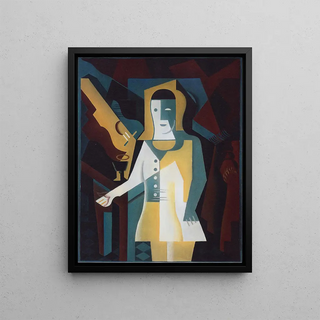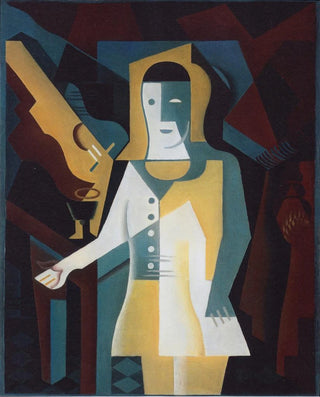Art print | Pierrot - Juan Gris


View from behind

Frame (optional)
Pierrot art print - Juan Gris – Captivating introduction
In the vibrant universe of modern art, certain works stand out for their ability to capture the essence of the era while transcending time. "Pierrot" by Juan Gris is one of these iconic creations. Created in 1919, this piece embodies cubism, but it goes far beyond simple geometric shapes. It evokes a sense of melancholy and introspection that resonate deeply with viewers. The figure of Pierrot, traditionally associated with sadness and solitude, is reinterpreted here by Gris, who manages to breathe new life into this emblematic theatrical character. Through this Pierrot art print - Juan Gris, we are invited to immerse ourselves in a world where emotions blend with aesthetic reflection.
Style and uniqueness of the work
The "Pierrot" piece stands out for its bold approach to cubism, an artistic movement that redefined visual perception in the early 20th century. Gris, a master of this technique, decomposes the figure of Pierrot into a series of facets, playing with angles and perspectives. The colors, though restrained, intertwine to create an atmosphere that is both melancholic and vibrant. Shades of blue and gray dominate, evoking a nostalgic mood, while touches of brighter colors illuminate the canvas, reflecting the complexity of human emotions. Every detail, every line, every nuance is carefully orchestrated to tell a story— that of a Pierrot both dreamer and disillusioned, a mirror of the human condition.
The artist and his influence
Juan Gris, born in Spain but active in Paris, is one of the pioneers of cubism, alongside figures such as Pablo Picasso and Georges Braque. However, his style is distinguished by a more structured approach and a unique sensitivity that is his own. Gris managed to marry the rigor of cubism with elements of surrealism, creating a work that speaks to both form and feeling. His influence extends well beyond his era, impacting generations of artists who sought to explore the relationship between reality and perception. By choosing to depict themes such as

Matte finish

View from behind

Frame (optional)
Pierrot art print - Juan Gris – Captivating introduction
In the vibrant universe of modern art, certain works stand out for their ability to capture the essence of the era while transcending time. "Pierrot" by Juan Gris is one of these iconic creations. Created in 1919, this piece embodies cubism, but it goes far beyond simple geometric shapes. It evokes a sense of melancholy and introspection that resonate deeply with viewers. The figure of Pierrot, traditionally associated with sadness and solitude, is reinterpreted here by Gris, who manages to breathe new life into this emblematic theatrical character. Through this Pierrot art print - Juan Gris, we are invited to immerse ourselves in a world where emotions blend with aesthetic reflection.
Style and uniqueness of the work
The "Pierrot" piece stands out for its bold approach to cubism, an artistic movement that redefined visual perception in the early 20th century. Gris, a master of this technique, decomposes the figure of Pierrot into a series of facets, playing with angles and perspectives. The colors, though restrained, intertwine to create an atmosphere that is both melancholic and vibrant. Shades of blue and gray dominate, evoking a nostalgic mood, while touches of brighter colors illuminate the canvas, reflecting the complexity of human emotions. Every detail, every line, every nuance is carefully orchestrated to tell a story— that of a Pierrot both dreamer and disillusioned, a mirror of the human condition.
The artist and his influence
Juan Gris, born in Spain but active in Paris, is one of the pioneers of cubism, alongside figures such as Pablo Picasso and Georges Braque. However, his style is distinguished by a more structured approach and a unique sensitivity that is his own. Gris managed to marry the rigor of cubism with elements of surrealism, creating a work that speaks to both form and feeling. His influence extends well beyond his era, impacting generations of artists who sought to explore the relationship between reality and perception. By choosing to depict themes such as






